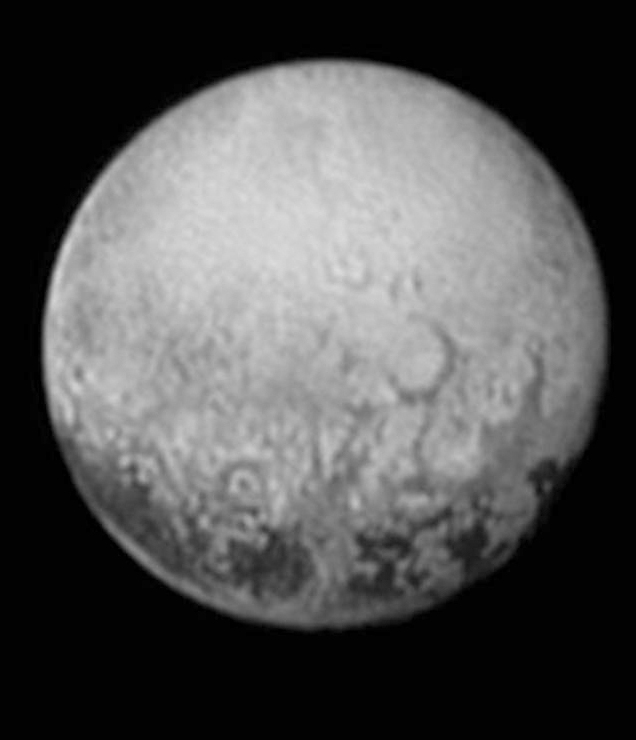CAPE CANAVERAL, Fla. — Pluto, reveal thyself, and Earthlings, enjoy the show.
On Tuesday, NASA’s New Horizons spacecraft will sweep past Pluto and present the previously unexplored world in all its icy glory.
It promises to be the biggest planetary unveiling in a quarter-century. The curtain hasn’t been pulled back like this since NASA’s Voyager 2 shed light on Neptune in 1989.
Now it’s little Pluto’s turn to shine way out on the frigid fringes of our solar system.
New Horizons has traveled 3 billion miles over 91/2 years to get to this historic point. The fastest spacecraft ever launched, it carries the most powerful suite of science instruments ever sent on a scouting and reconnaissance mission of a new, unfamiliar world.
The size of a baby grand piano, the spacecraft will come closest to Pluto on Tuesday morning – at 7:49 a.m. EDT. That’s when New Horizons is predicted to pass within 7,767 miles of Pluto. Fourteen minutes later, the spacecraft will zoom within 17,931 miles of Charon, Pluto’s jumbo moon.
For plutophiles, it will be cause to celebrate, especially for those gathered at the operations center at Johns Hopkins University’s Applied Physics Laboratory in Laurel, Maryland. The lab designed and built the spacecraft for NASA, and has been managing its roundabout route through the solar system.
“What NASA’s doing with New Horizons is unprecedented in our time and probably something close to the last train to Clarksville, the last picture show, for a very, very long time,” said Alan Stern, a planetary scientist with the Southwest Research Institute in Boulder, Colorado.
It is the last stop in NASA’s quest to explore every planet in the solar system, starting with Venus in 1962. And in a cosmic coincidence, the Pluto visit falls on the 50th anniversary of the first-ever flyby of Mars, by Mariner 4.
Pluto is no longer an official planet, merely a dwarf, but it still enjoyed full planet status when New Horizons rocketed from Cape Canaveral, Florida, on Jan. 19, 2006. Pluto’s demotion came just seven months later, a sore subject still for many.
“We’re kind of running the anchor leg with Pluto to finish the relay,” Stern said.
The sneak peeks of Pluto in recent weeks are getting “juicier and juicier,” said Johns Hopkins project scientist Hal Weaver. “The science team is just drooling over these pictures.”
The Hubble Space Telescope previously captured the best pictures of Pluto. If the pixelated blobs of pictures had been of Earth, though, not even the continents would have been visible. The New Horizons team is turning “a point of light into a planet,” Stern said.
An image released last week showed a copper-colored Pluto bearing, a large, bright spot in the shape of a heart.
Scientists expect image resolution to improve dramatically by Tuesday. The 7,767-mile span at closest approach is about the distance between Seattle and Sydney.
New Horizons, weighing less than 1,000 pounds including fuel, has seven instruments that will be going full force during the encounter. It’s expected to collect 5,000 times as much data as the Mariner 4 flyby of Mars.
“We’re going to rewrite the book,” Weaver said. “This is it – this is our once-in-a-lifetime opportunity to see it.”
The team gets one crack at this.
“We’re trying to hit a very small box, relatively speaking,” said Mark Holdridge, the encounter mission manager. “It’s 60 by 90 miles, and we’re going 30,000 mph, and we’re trying to hit that box within a plus or minus 100 seconds.”
The only planet in our solar system discovered by an American, Pluto actually is a mini solar system unto itself. Pluto – just two-thirds the size of our own moon – has big moon Charon that’s just over half its size, as well as baby moons Styx, Nix, Hydra and Kerberos. The names are associated with the underworld in which the mythological god, Pluto, reigned. New Horizons will observe each known moon and keep a lookout for more.
Scientists involved in the $700 million effort want to get a good look at Pluto and Charon, and get a handle on their surfaces and chemical composition.
They also plan to measure the temperature and pressure in Pluto’s nitrogen-rich atmosphere and determine how much gas is escaping into space. Temperatures can plunge to nearly minus-400 degrees. A liquid ocean and a rocky core may lie beneath the icy shell.
Send questions/comments to the editors.



Success. Please wait for the page to reload. If the page does not reload within 5 seconds, please refresh the page.
Enter your email and password to access comments.
Hi, to comment on stories you must . This profile is in addition to your subscription and website login.
Already have a commenting profile? .
Invalid username/password.
Please check your email to confirm and complete your registration.
Only subscribers are eligible to post comments. Please subscribe or login first for digital access. Here’s why.
Use the form below to reset your password. When you've submitted your account email, we will send an email with a reset code.